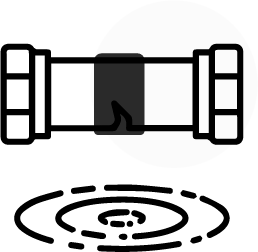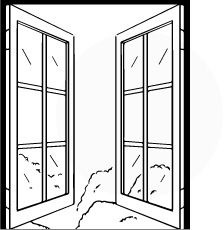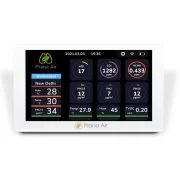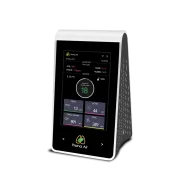
Humidity is the term for the gaseous water content in the air. The quantity of gaseous water (water vapor) in the atmosphere is known as HUMIDITY, which can change when water is present in excess amounts. For example, when it is about to rain, there is a lot of water vapor in the air.
Where does Humidity come from?
There are many factors that decide the humidity of a place, both indoors and outdoors. Temperature plays an important role in deciding the relative humidity indoors as well as outdoors. For example, when the temperature is hot, the humidity decreases as the air can hold more water content; but when the temperature decreases, the air cannot hold much moisture, and the relative humidity increases. Therefore, when the temperature indoors is cold or hot enough, we need to warm or cool it up, respectfully, to maintain the ideal humidity levels. When there is 100% humidity in the air, it will rain as the air won’t be able to hold more water vapour.

What is the difference between
Relative Humidity & Absolute Humidity?
Relative Humidity
The ratio of the amount of water vapour in the atmosphere to the highest amount of vapour that the air can hold is known as relative humidity.
Absolute Humidity
Whereas the quantity of water vapour present in a particular amount of air at a given time and temperature is known as absolute humidity.
![]()
Are humidity and moisture the same?
Humidity is the amount of water vapour in the air in its gaseous state. Whereas moisture is the content of water in its liquid state. When air reaches its limit to absorb water in the form of water vapour, water will begin to condense as drops in the air that is why clouds form. That is known as moisture. When humidity reaches its peak, rainfall happens, that is moisture.
Factors that affect Humidity Level
Indoor & Outdoor
Outdoors Environment
 Air Movement
Air Movement
Higher wind speeds result in less water evaporation and lower humidity, while lower wind speeds result in more evaporation & higher humidity.
 Temperature
Temperature
The air can store more water vapour when the temperature increases, hence a warmer atmosphere may have a higher humidity level.
 Wind Speed
Wind Speed
Lower wind speeds result in more water evaporation & higher humidity, while higher wind speeds result in less evaporation & lower humidity.

Precipitation
The humidity will rise the longer it rains because the air is constantly absorbing water.
 Air Pressure
Air Pressure
Humidity depends on the atmospheric pressures at different geographical locations, temperature, and air pressure in the respective area.
Indoor Environment
 Cooking or boiling water
Cooking or boiling water
Cooking and water boiling activities release water vapour in the air. This will add to the relative humidity of that room.
 Appliances such as Gas Heaters
Appliances such as Gas Heaters
One litre of moisture is produced every hour while using a non-fueled gas heater.
 Ventilation Rate
Ventilation Rate
High humidity indicates inadequate ventilation. Extremely high indoor humidity is linked to an increase in the development of bacteria and mould.
 Drying the clothes indoors
Drying the clothes indoors
Drying the clothes indoors can increase the relative humidity of a room and therefore will increase the risks of mould and bacteria growth.
 Water leakages
Water leakages
Water leakages can increase both moisture & humidity. As a result, the air will become stale & the chances of getting sick due to bacteria will increase.
What Happens When Humidity Level
Is Very Low & High?
The ideal or healthy range of humidity should be maintained between 30-60%. Humidity is unhealthy
when it exceeds or is lower than the ideal limit, it causes many discomforts and
can result in the growth of mold and bacteria.
When humidity is high (> or = to 60%)
 Encourages Mold & Mildew
Encourages Mold & Mildew
When relative humidity is more than 60%, it can promote the growth of mold and mildew. Certain types of toxic molds can seriously impact one’s health, for example, black mold is considered very dangerous for humans.
 Virus and bacteria
Virus and bacteria
When you spend too much time in too humid conditions, it might trigger allergies & make you sick. Viruses and bacteria thrive in humidity above 60% which can cause various respiratory illness symptoms.

Excess Sweating
Humidity means that the air contains water vapour. When the air becomes more humid, people experience excessive sweating as the sweat will not evaporate easily or will take more time than usual due to high water vapour in the air.
 Increased Respiration
Increased Respiration
Due to high temperature, when our bodies heat up naturally, we sweat. That sweat then evaporates to keep our bodies cool. Due to excess moisture in the air, our bodies need to work harder to cool off. This increases blood circulation and respiration.
 Damage Your Belongings
Damage Your Belongings
High humidity can damage your furniture, floorings, wallpaper, paintwork, etc. High humidity results in condensation that gather on your walls. So, the paint will start to flake and the wallpaper will curl up.
When humidity is low (< 30%)
 Germs and Viruses
Germs and Viruses
Due to low humidity, germs & viruses disperse, and travel around freely. As a result, they thrive in low humidity, and diseases such as RTIs are more common when relative humidity is low.

Susceptibility to respiratory diseases
Low humidity and low temperatures result in more susceptibility to catching respiratory diseases, colds, and many other respiratory tract infections like sinusitis, otitis, bronchitis, and pneumonia. This is because low humidity will result in drying out the airways.
 Dry Hair and Dry Skin
Dry Hair and Dry Skin
When the air has low humidity, skin, and hair do not retain or get enough moisture. As a result, the skin will flake resulting in skin irritation and itching and can worsen skin conditions like eczema and psoriasis. Whereas hair will become more dry, frizzy, dull, and will break more often.
 Influenza
Influenza
Low relative humidity results in chances of spreading influenza. Low humidity further reduces the ability of cilia (hair-like structures in the airway cells) in removing viruses such as Covid 19 and preventing damage done to the lungs due to such viruses.
 Decreased performance
Decreased performance
Even minor variations in relative humidity and temperature can create measurable changes in your abilities to concentrate or accomplish tasks, especially in places like schools and offices where concentration is extremely important.
How To Maintain the Good Humidity Indoor?
Healthy or ideal indoor relative humidity levels should be between 30-60%.
Fix any leakages or pipe leaks
Fix any broken pipes, faucets, and leakages that can result in more moisture and condensation indoors.
Dry your clothes outside
It’s recommended to dry your laundry outdoors as they can increase the relative humidity of a room if dried indoors.
Relocate your indoor plants
If the relative humidity of a room is higher and it has plants in that room, consider relocating them as they are a potential source.
Use Dehumidifiers
Dehumidifiers will help you reduce the relative humidity of your space if you have high humidity problems in your room.
Use charcoal pieces
Charcoal is a great absorber. A single piece of charcoal can reduce humidity levels in your air. They just need to be replaced every 2-3 months.
Open windows
Opening windows in areas with high humidity such as bathrooms is one of the easy solutions. This will increase ventilation as well.
Humidity levels and what do they mean?
Healthy or ideal indoor relative humidity levels should be between 30-60%
| Humidity Level | What does it mean? |
| = 70% | Dust mites, the most common dust allergens for asthma, thrive when relative humidity is at or above 70. |
| 30-60% | Ideal relative humidity indoors. |
| >30% | Low relative humidity. Increases the chances of catching airborne viruses. Eye, nose, and throat dryness. |
Healthy or ideal indoor relative humidity levels should be between 30-60%. Humidity levels >= 70% promote the growth of dust mites, the most common dust allergens for asthma, and they thrive when relative humidity is at or above 70. Humidity levels below 30% mean relative humidity is low that increases the chances of catching airborne viruses. Eye, nose, and throat dryness.
WHO Guidelines of Humidity
| Measure | Risk Estimate |
| Self-reported humidity | – 2.71 (1.07–6.91) for cold – 3.02 (1.14–7.98) for sore throat |
| Signs of high humidity | – 3.97 (3.74–4.22) |
| Absolute indoor humidity > median, 5.8 g/kg | – 1.7 (1.0–2.9) |
| Relative humidity > 45% | – 0.8 (0.4–1.5) |
| Absolute indoor humidity level | – > 5.8 g/m3, 2.0 (1.2–3.4) |

